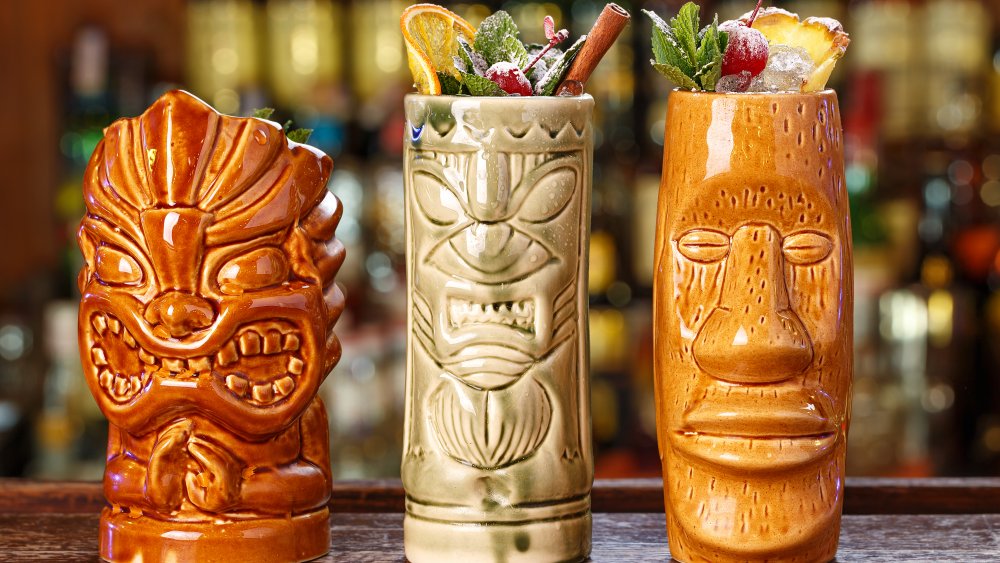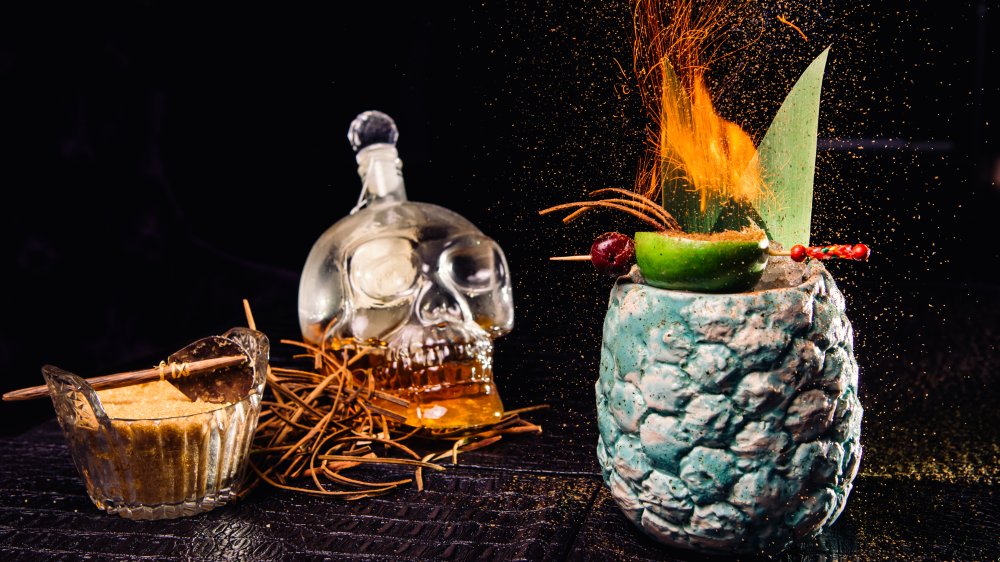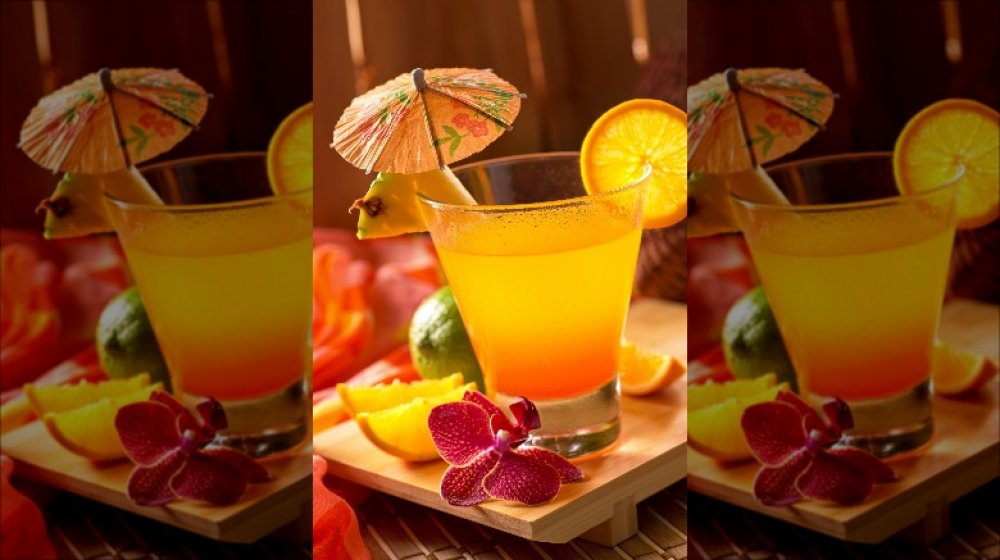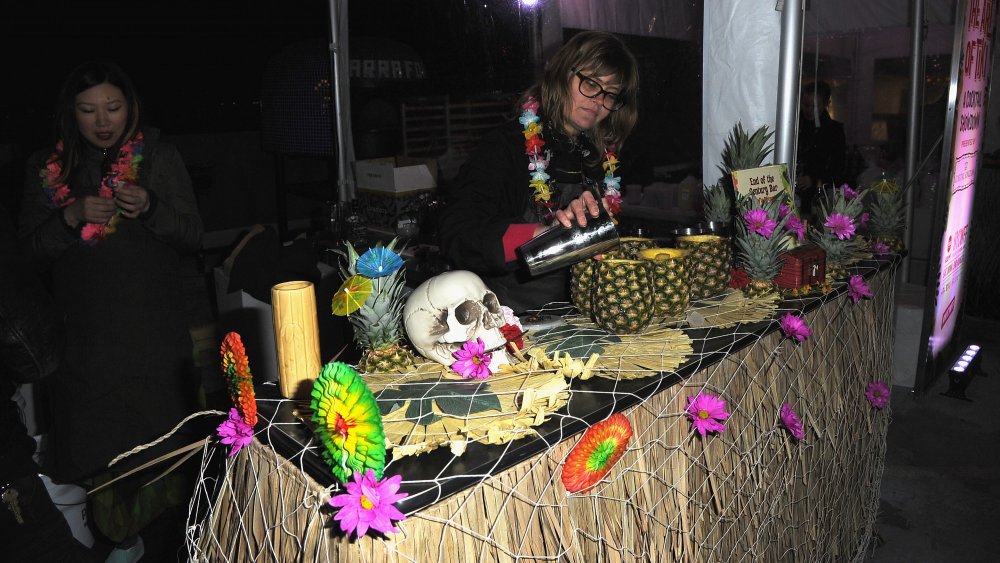The Surprising History Of Tiki Drinks
Tiki drinks are never out of style. Okay, so maybe they've always been a bit outside the mainstream, but they nonetheless have a certain je ne sais cool that means they'll always be appreciated wherever people dream of tropical islands and thrill to the sounds of Don Ho singing "Tiny Bubbles."
What all tiki drinks seem to have in common, besides awesomely kitschy drinkware, is the fact that they are often sweet, usually quite colorful (particularly when garnished with what appears to be half the produce from the Waikiki Farmers Market), and inevitably much more potent than you'd expect them to be. Kind of a "wrap a brick in a slice of pineapple and use it to smash in your skull" effect, should you have more than two at a time.
While anything that is served in a ceramic coconut shell most likely does not have a long and noble pedigree behind it, tiki drinks may be somewhat older than you think. The first tiki lounge opening up just months after the repeal of the unpopular 18th amendment that had forced the nation into a decade and a half of unwanted sobriety.
It all started with Don the Beachcomber
In 1934, as Behind the Bar relates, a man named Ernest Gantt returned to the U.S. from several years spent roaming the South Sea Islands. Perhaps not coincidentally, that was just about the time you could finally get a drink again, so he took advantage of a Prohibition-parched populace and opened a bar. Not just any bar, though — he decorated his Hollywood lounge in pseudo-Polynesian style complete with rattan and flaming torches (which somehow did not wind up burning the place down), and served up Chinese-ish cuisine and super-strong fruity rum drinks.
As Hollywood itself grew to become the entertainment capital of the universe, so, too, did Gantt's little grass shack expand to a chain with 16 locations, and Barstool Sports tells us that Don the Beachcomber gifted the world with its first Pu Pu Platter as well as drinks including Navy Grog, Tahitian Rum Punch, the Fog Cutter, and the legendary Zombie. Gantt himself was so inspired by his establishment that he renamed himself in its honor, legally changing his name to Donn Beachcomber and later shortening this to Donn Beach.
Trader Vic made tiki drinks huge in the post-war world
Behind the Bar also gives a shout-out to Vic Bergeron, a man who, in 1937, changed the name of his Oakland bar to Trader Vic's and adopted a Don the Beachcomber-inspired tropical theme. By the time World War II was over, soldiers and sailors returning from duty in the Pacific Theater brought back with them a craze for all things South Pacific (including South Pacific, which, according to Broadway Musical Home, was a best-selling book in 1947 and a Broadway musical by 1949). Professional Bartenders Unlimited also notes the fact that by this time airline travel was making Hawaii a more accessible and affordable vacation destination, so Hawaii was very much in vogue in mid-century America, both before and after attaining statehood in 1959.
Trader Vic knew how to surf this rising wave of popularity, and soon his tiki lounges were spread all over the country and had spawned numerous knockoffs of their own — there was even an Enchanted Tiki Room (sadly, not a cocktail lounge) at Disneyland. Even if Vic hadn't plastered his name all over a nationwide chain of restaurants and products, he would have gone down in history for creating a drink so tasty that it caused his Tahitian friends to exclaim, "Maita'i roa a'e," which translates to "Out of this world — the best!" He shortened this exclamation to mai tai, and thus was christened a new cocktail classic (via Eater).
Millennials brought tiki back to life
Yes, we've all heard that millennials kill off trend after trend, and it's an oft-quoted maxim that hipsters ruin everything. And yet, when it comes to tiki culture, tiki lounges, and tiki drinks, it's actually hipsters and millennials (not to mention hipster millennials) who breathed new life into to this once-zombified fad.
Tiki bars were on the decline by the late 1960s, and by the '70s and '80s they were as rare as a paper umbrella in a dry martini. Just about the only tiki drink still available on most cocktail menus was the piña colada, although of course by this time it was much too embarrassing to order one for fear that somebody would then ask if you liked getting caught in the rain, had half a brain, etc. We'll discreetly draw a curtain on this sad chapter in tiki history and fast forward to the mid-'90s, at which time new millennium Tiki King-to-be Jeff "Beachbum" Berry began his Indiana Jones-like quest to discover the secret of the Lost Tiki Drink Recipes. He did, in fact, fulfill this quest quite admirably, publishing seven recipe books, opening New Orleans' critically acclaimed Latitude 29 new-gen tiki lounge, and pretty much single-handedly sparking what The Atlantic refers to as "today's tiki renaissance." Let's all raise a skull-shaped, tropical fruit-bedecked, and possibly even flaming glass to Donn, Vic, and Beachbum, the holy trinity of tiki drinking.



